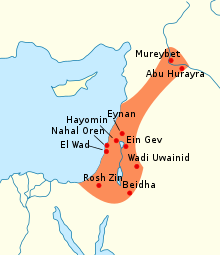Wadi an-Natuf
 |
|
| Geographical range | Levant |
|---|---|
| Period | Epipaleolithic |
| Dates | c. 12,500–9,500 BC |
| Type site | Shuqba cave (Wadi an-Natuf) |
| Major sites | Shuqba cave, Ain Mallaha, Ein Gev, Tell Abu Hureyra |
| Preceded by | Kebaran |
| Followed by | Khiamian, Shepherd Neolithic |
| The Mesolithic The Epipaleolithic |
|---|
| ↑ Paleolithic |
|
| ↓ Neolithic ↓ Stone Age |
The Epipaleolithic Natufian culture (/nəˈtuːfiən/) existed from around 12,500 to 9,500 BC in the Levant, a region in the Eastern Mediterranean. The culture was unusual in that it supported a sedentary or semi-sedentary population even before the introduction of agriculture. The Natufian communities may be the ancestors of the builders of the first Neolithic settlements of the region, which may have been the earliest in the world. Natufians founded Jericho which may be the oldest city in the world. Some evidence suggests deliberate cultivation of cereals, specifically rye, by the Natufian culture, at Tell Abu Hureyra, the site of earliest evidence of agriculture in the world. Generally, though, Natufians exploited wild cereals. Animals hunted included gazelles. According to Christy G. Turner II, there is archaeological and physical anthropological evidence for a relationship between the modern Semitic-speaking populations of the Levant, Persian Gulf and the Natufians. However modern Levantines have substantial Iran Neolithic/Chalcolithic, Anatolia Neolithic and Caucasus Hunter Gatherer-like admixture since the Bronze Age.
Dorothy Garrod coined the term Natufian based on her excavations at Shuqba cave (Wadi an-Natuf) located in the western Judean Mountains.
...
Wikipedia
